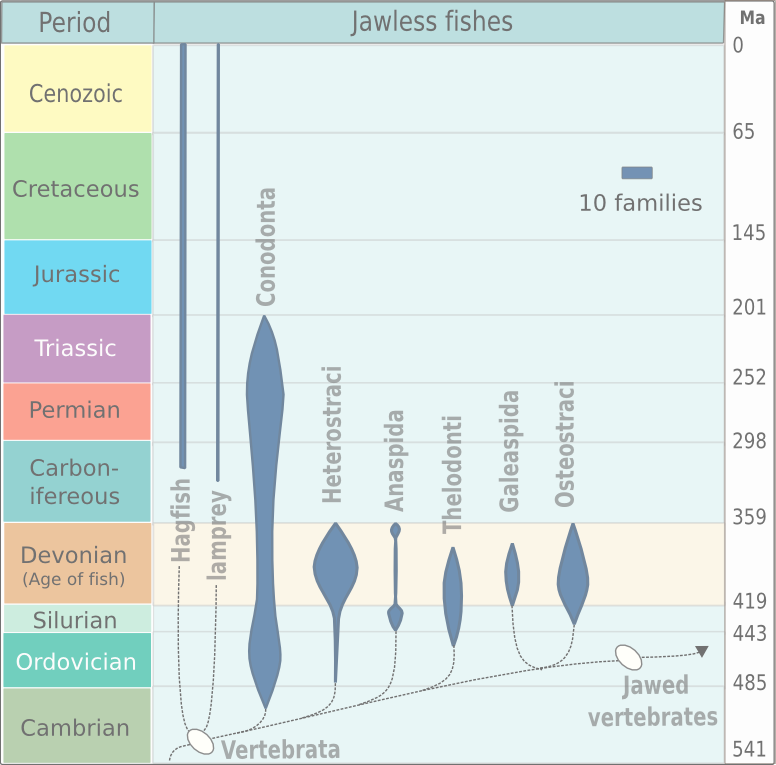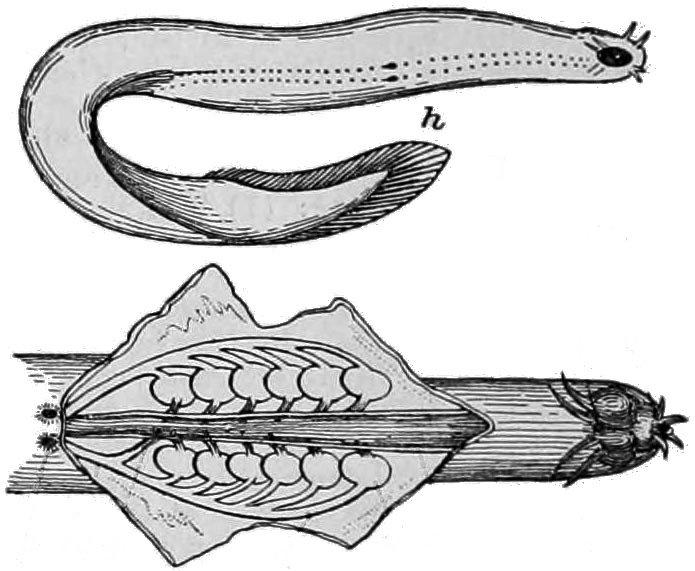|
Cyclostomes
Cyclostome is a biological term (from the Greek for "round mouth") used in a few different senses: * for the taxon Cyclostomi, which comprises the extant jawless fishes: the hagfish (Myxini) and the lampreys (Petromyzontidae). This was thought for a time to be a paraphyletic group and this usage of the term was deprecated by some. However, there is strong molecular evidence for cyclostome monophyly, and thus the term remains in use. * for the Order Cyclostomatida Cyclostomatida, or cyclostomata (also known as cyclostomes), are an ancient order of stenolaemate bryozoans which first appeared in the Lower Ordovician. It consists of 7+ suborders, 59+ families, 373+ genera, and 666+ species. The cyclostome ... of bryozoans, tiny animals that live in colonies and form large calcitic skeletons. * for one of two subgroups of braconid wasps. References {{Animal common name ... [...More Info...] [...Related Items...] OR: [Wikipedia] [Google] [Baidu] |
Cyclostomi
Cyclostomi, often referred to as Cyclostomata , from Ancient Greek κύκλος (kúklos), meaning "circle", and στόμα (stóma), meaning "mouth", is a superclass of vertebrates that comprises the living jawless fish classes: the lampreys and hagfishes. Both groups have jawless mouths with horny epidermal structures that function as teeth called ceratodontes, and branchial arches that are internally positioned instead of external as in the related jawed fishes. The superclass was named by Joan Crockford-Beattie. Possible external relationships This taxon is often included in the paraphyletic infraphylum Agnatha, which also includes several groups of extinct armored fishes called ostracoderms. Most fossil agnathans, such as galeaspids, thelodonts, and osteostracans, are more closely related to vertebrates with jaws (called gnathostomes) than to cyclostomes. Biologists historically disagreed on whether cyclostomes are a clade. The "vertebrate hypothesis" h ... [...More Info...] [...Related Items...] OR: [Wikipedia] [Google] [Baidu] |
Agnatha
Agnatha (; ) or jawless fish is a paraphyletic infraphylum of animals in the subphylum Vertebrata of the phylum Chordata, characterized by the lack of jaws. The group consists of both extant taxon, living (Cyclostomi, cyclostomes such as hagfishes and lampreys) and Extinction, extinct clades (e.g. conodonts and Cephalaspidomorphi, cephalaspidomorphs, among others). They are sister taxon, sister to vertebrates with jaws known as gnathostomes, who evolution, evolved from jawless ancestors during the early Silurian by developing folding joint, articulations in the first pairs of gill arches. Sequencing, Molecular data, both from rRNA and from mtDNA as well as Embryology, embryological data, strongly supports the hypothesis that both groups of living agnathans, hagfishes and lampreys, are more closely related to each other than to Gnathostomata, jawed fish, forming the Class (biology), superclass Cyclostomi. The oldest fossil agnathans appeared in the Cambrian. Living jawless fish c ... [...More Info...] [...Related Items...] OR: [Wikipedia] [Google] [Baidu] |
Cyclostomatida
Cyclostomatida, or cyclostomata (also known as cyclostomes), are an ancient order of stenolaemate bryozoans which first appeared in the Lower Ordovician. It consists of 7+ suborders, 59+ families, 373+ genera, and 666+ species. The cyclostome bryozoans were dominant in the Mesozoic; since that era, they have decreased. Currently, cyclostomes seldom constitute more than 20% of the species recorded in regional bryozoan faunas. Taxonomy Traditionally, cyclostomes have been divided into two groups according to the skeletal organization. In free-walled (or double-walled) cyclostomes, the exterior frontal walls of the zooids are uncalcified; autozooids have either a polygonal aperture bounded by vertical interior walls, or a subcircular aperture in species with kenozooids filling the spaces between the autozooids. By contrast, fixed-walled (or single-walled) cyclostomes have much of the exterior frontal wall calcified; autozooids normally have a subcircular aperture located at ... [...More Info...] [...Related Items...] OR: [Wikipedia] [Google] [Baidu] |
Biology
Biology is the scientific study of life and living organisms. It is a broad natural science that encompasses a wide range of fields and unifying principles that explain the structure, function, growth, History of life, origin, evolution, and distribution of life. Central to biology are five fundamental themes: the cell (biology), cell as the basic unit of life, genes and heredity as the basis of inheritance, evolution as the driver of biological diversity, energy transformation for sustaining life processes, and the maintenance of internal stability (homeostasis). Biology examines life across multiple biological organisation, levels of organization, from molecules and cells to organisms, populations, and ecosystems. Subdisciplines include molecular biology, physiology, ecology, evolutionary biology, developmental biology, and systematics, among others. Each of these fields applies a range of methods to investigate biological phenomena, including scientific method, observation, ... [...More Info...] [...Related Items...] OR: [Wikipedia] [Google] [Baidu] |
Greek Language
Greek (, ; , ) is an Indo-European languages, Indo-European language, constituting an independent Hellenic languages, Hellenic branch within the Indo-European language family. It is native to Greece, Cyprus, Italy (in Calabria and Salento), southern Albania, and other regions of the Balkans, Caucasus, the Black Sea coast, Asia Minor, and the Eastern Mediterranean. It has the list of languages by first written accounts, longest documented history of any Indo-European language, spanning at least 3,400 years of written records. Its writing system is the Greek alphabet, which has been used for approximately 2,800 years; previously, Greek was recorded in writing systems such as Linear B and the Cypriot syllabary. The Greek language holds a very important place in the history of the Western world. Beginning with the epics of Homer, ancient Greek literature includes many works of lasting importance in the European canon. Greek is also the language in which many of the foundational texts ... [...More Info...] [...Related Items...] OR: [Wikipedia] [Google] [Baidu] |
Hagfish
Hagfish, of the Class (biology), class Myxini (also known as Hyperotreti) and Order (biology), order Myxiniformes , are eel-shaped Agnatha, jawless fish (occasionally called slime eels). Hagfish are the only known living Animal, animals that have a skull but no vertebral column, although they do have rudimentary vertebrae. Hagfish are marine animal, marine predators and scavengers that can defend themselves against other larger predators by releasing copious amounts of slime coat, slime from mucous glands in their skin. Although their exact relationship to the only other extant taxon, living group of Agnatha, jawless fish, the lampreys, was long the subject of controversy, genetic evidence suggests that hagfish and lampreys are more closely related to each other than to jawed vertebrates, thus forming the superclass Cyclostomi. The oldest-known stem group hagfish are known from the Pennsylvanian (geology), Late Carboniferous, around Moscovian (Carboniferous), 310 million years ... [...More Info...] [...Related Items...] OR: [Wikipedia] [Google] [Baidu] |
Lamprey
Lampreys (sometimes inaccurately called lamprey eels) are a group of Agnatha, jawless fish comprising the order (biology), order Petromyzontiformes , sole order in the Class (biology), class Petromyzontida. The adult lamprey is characterized by a toothed, funnel-like sucking mouth. The common name "lamprey" is probably derived from Latin , which may mean "stone licker" ( "to lick" + "stone"), though the etymology is uncertain. "Lamprey" is sometimes seen for the plural form. About 38 extant species of lampreys are known, with around seven known extinct species. They are classified in three families—two small families in the Southern Hemisphere (Geotriidae, Mordaciidae) and one large family in the Northern Hemisphere (Petromyzontidae). Genetic evidence suggests that lampreys are more closely related to hagfish, the only other living group of jawless fish, than they are to jawed vertebrates, forming the superclass Cyclostomi. The oldest fossils of stem-group lampreys are ... [...More Info...] [...Related Items...] OR: [Wikipedia] [Google] [Baidu] |
Paraphyletic
Paraphyly is a taxonomic term describing a grouping that consists of the grouping's last common ancestor and some but not all of its descendant lineages. The grouping is said to be paraphyletic ''with respect to'' the excluded subgroups. In contrast, a monophyletic grouping (a clade) includes a common ancestor and ''all'' of its descendants. The terms are commonly used in phylogenetics (a subfield of biology) and in the tree model of historical linguistics. Paraphyletic groups are identified by a combination of synapomorphies and symplesiomorphies. If many subgroups are missing from the named group, it is said to be polyparaphyletic. The term received currency during the debates of the 1960s and 1970s accompanying the rise of cladistics, having been coined by zoologist Willi Hennig to apply to well-known taxa like Reptilia (reptiles), which is paraphyletic with respect to birds. Reptilia contains the last common ancestor of reptiles and all descendants of that ancestor exc ... [...More Info...] [...Related Items...] OR: [Wikipedia] [Google] [Baidu] |
Monophyly
In biological cladistics for the classification of organisms, monophyly is the condition of a taxonomic grouping being a clade – that is, a grouping of organisms which meets these criteria: # the grouping contains its own most recent common ancestor (or more precisely an ancestral population), i.e. excludes non-descendants of that common ancestor # the grouping contains all the descendants of that common ancestor, without exception Monophyly is contrasted with paraphyly and polyphyly as shown in the second diagram. A ''paraphyletic'' grouping meets 1. but not 2., thus consisting of the descendants of a common ancestor, excepting one or more monophyletic subgroups. A ''polyphyletic'' grouping meets neither criterion, and instead serves to characterize convergent relationships of biological features rather than genetic relationships – for example, night-active primates, fruit trees, or aquatic insects. As such, these characteristic features of a polyphyletic grouping are ... [...More Info...] [...Related Items...] OR: [Wikipedia] [Google] [Baidu] |




